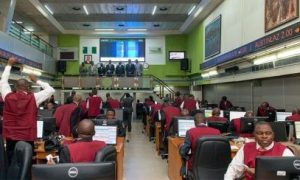Global Economy
According to the Bureau of Labor Statistics (BLS), United States headline inflation rose higher than market expectations (+3.4% y/y), increasing by 30bps to 3.5% y/y in March (February: +3.2% y/y) – the highest print since September 2023 (+3.7% y/y). We attribute the inflationary pressures mainly to the uptick in energy prices (+2.1% y/y vs February: -1.9% y/y) driven by higher gasoline prices (+1.3% y/y vs February: -3.9% y/y) amid slower deceleration in utility gas services (-3.2% y/y vs February: -8.8% y/y) and fuel oil (-3.7% y/y vs February: -5.4% y/y) prices. Meanwhile, food prices were steady at 2.2% y/y increase relative to February, as the slower costs of food away from home (+4.2% y/y vs February: +4.5% y/y) balanced the higher prices for food at home (+1.2% y/y vs February: +1.0% y/y). On a month-on-month basis, the headline inflation rose by 0.4% m/m in March (February: +0.4% m/m). Given the higher energy prices and recent job numbers, we expect the inflationary pressures to remain elevated in the short to medium term. At the same time, considering the sticky inflation and signs of robust economic growth, we think the Fed’s first rate reduction may be delayed until September, with the Committee possibly opting to lower rates only twice this year. Indeed, the CME FedWatch tool now indicates probabilities of a “HOLD” decision in May to July policy meetings, with a 69.3% probability of a rate cut in September.
At its April policy meeting, the Governing Council of the European Central Bank (ECB) voted to keep its key interest rates steady in line with market expectations. Notably, this marks the fifth consecutive time the ECB has opted to keep the key policy rates steady, maintaining the main refinancing operations, marginal lending facility, and deposit lending facility at 4.50%, 4.75%, and 4.00%, respectively. While acknowledging the recent slowdown in inflation, the Council stated that underlying price pressures, particularly wages in the bloc’s extensive services sector, remain notably high, posing a risk of a potential reversal in price trends. Consequently, the ECB indicated potential consideration for easing the level of policy restriction if it becomes more confident about inflation progressing steadily toward the 2.0% medium-term target. However, the Governing Council emphasized its commitment to a data-dependent and meeting-by-meeting approach in determining the appropriate degree and duration of restraint without pre-committing to the rate path. The committee’s body language suggests that a rate reduction could be imminent, bolstered by the better-than-expected deceleration in inflation and sluggish growth. With this in mind, we think the ECB may implement its first rate cut during the June policy meeting should prices continue to moderate. Nevertheless, we do not rule out the possibility of the apex bank maintaining rates at current levels in the near term if sustained wage increases trigger an upward movement of inflation.
Global Equities
The global equities market experienced mixed sentiments this week as investors grappled with new inflation data, which dampened expectations regarding the timing and magnitude of potential interest rate cuts by the Federal Reserve. Accordingly, US equities (DJIA: -1.1%; S&P 500: -0.1%) were poised for their second consecutive weekly decline, as the March consumer inflation report diminished hopes of a June rate cut by the Federal Reserve. Elsewhere, European equities (STOXX Europe: +0.5%; FTSE 100: +1.0%) were on track to finish the week higher as investors digested UK GDP data and ECB interest rate decision. In Asia, the Chinese market (SSE: -1.6%) faced pressure due to several factors, including (1) currency weakness, (2) disappointing economic data relating to inflation and trade, and (3) reduced expectations for US interest rate cuts. Meanwhile, the Japanese market (Nikkei 225: +1.4%) rebounded from last week’s losses driven by a weaker yen and gains in tech stocks. Emerging Markets Index (MSCI EM: +0.9%) remained positive, supported by bullish sentiments in India (+0.3%) and Taiwan (+2.0%), while the Frontier Markets index (MSCI FM: -1.4%) declined following the loss in Romania (-0.6%).
Nigeria: Domestic Economy
Based on the recently released data by the Nigerian Upstream Petroleum Regulatory Commission (NUPRC), Nigeria’s crude oil production (including condensates) maintained its downtrend for the second consecutive month, declining by 6.6% m/m to 1.44 mb/d in March (February: 1.54 mb/d) – the lowest level in 7 months. The production decline highlights the headwinds in the Nigerian oil sector such as oil theft, vandalism and infrastructure decay amid the reduced investments in existing terminals with International Oil Companies (IOC) looking to exit Nigeria’s major assets. Precisely, crude oil production declined significantly across the Akpo (-28.2% m/m), Bonga (-17.9% m/m), Usan (-16.0% m/m), and Bonny (-5.8% m/m) terminals, while production increased across the Forcados (+1.9% m/m), Escravos (+10.4% m/m) and Qua Iboe (+10.4% m/m) terminals. Overall, average crude oil production (including condensates) settled at 1.54 mb/d in Q1-24 (Q4-23: 1.53 mb/d). Whilst we expect the government to continue to intensify its efforts to curb oil theft, we think the challenges affecting production will continue to pose downside risks to output in the near term. Thus, we review our average crude oil production estimate (including condensate) downwards to 1.56 mb/d in 2024E (Previous: 1.59 mb/d).
According to the Domestic and Foreign Portfolio Report of the Nigerian Exchange (NGX), total transactions in the domestic equities market declined by 45.1% m/m to NGN357.88 billion in February (January: NGN651.52 billion). We highlight that domestic investors primarily drove the decline in the review period, with domestic inflows (81.6% of market transactions) dropping by 51.2% m/m to NGN292.07 billion (January: NGN598.41 billion) due to investors preference for fixed income yields at current levels. Meanwhile, foreign transactions (18.4% of gross transactions) increased by 23.9% m/m to NGN65.81 billion (January: NGN53.11 billion) as foreign investors continued to respond positively to recent initiatives by the CBN on fixing FX inadequacies. Looking ahead, we expect domestic investors to continue to dominate market performance, though rising FI yields may constrain buying activities. At the same time, we believe the CBN’s policies around fixing FX inadequacies will continue to bolster investor confidence and encourage the continued return of foreign investors. Consequently, we expect sustained improvements in foreign participation in the short term.
Capital Markets: Equities
Risk-off sentiments resonated in the Nigerian equities market in the two trading sessions this week, influenced by a three-day public holiday from Tuesday to Thursday to commemorate the Eid-el-Fitr celebration. In this limited trading window, investors once again took profits off the banks – most predominantly GTCO (-13.8%), FBNH (-11.2%) and ZENITHBANK (-5.9%). Accordingly, the All-Share Index declined by 1.1% w/w to close at 102,314.56 points, resulting in MTD and YTD returns of -2.1% and +36.8%, respectively. Activity level was also impacted by the shortened trading week, as the total trading volume and value weakened by 69.2% w/w and 50.5% w/w, respectively. Sectoral performance was negative, reflecting the sour mood in the market. Precisely, all the major sectoral indices – Banking (-7.2%), Insurance (-2.4%), Consumer Goods (-1.3%), Oil and Gas (-0.3%) and Industrial Goods (-0.2%) – recorded declines.
Looking ahead, we anticipate that market sentiments will remain negative, with investors continuing to react unfavorably to the potential dilution stemming from the CBN’s recapitalization initiative. In the medium term, we expect investors’ sentiments to be influenced by developments in the macroeconomic landscape and corporate actions.
Money market and fixed income
The overnight (OVN) rate expanded by 707bps w/w to 30.1%, due to the depressed liquidity from the prior week and the absence of significant inflows to support the financial system this week. Against the preceding, average system liquidity settled lower at a net long position of NGN255.45 billion (vs a net long position of NGN467.73 billion in the previous week).
Next week, we envisage the OVN rate trending upward as we expect the debits for this month’s FGN bond (NGN450.00 billion) auction and net NTB issuance (NGN802.19 billion) to offset the sole inflow from FGN bond coupon payment (NGN145.98 billion) and exert pressure on system liquidity.
Treasury bills
Following the shortened trading week, activities in the T-bills secondary market were mostly calm, with pockets of demand particularly at the long end of the curve. As a result, the average yield across all instruments contracted by 9bps to 18.7%. Across the segments, the average yield declined by 5bps to 18.9% in the NTB secondary market and dipped by 20bps to 18.2% in the OMO segment. At this week’s NTB auction, the apex bank offered instruments worth NGN149.63 billion – NGN2.78 billion of the 91-day, NGN3.02 billion of the 182-day, and NGN143.84 billion of the 365-day bills – to participants. Total subscription at the auction settled at NGN182 trillion (bid-to-offer: 12.2x), with more demand skewed towards the longer-dated bill (NGN1.77 trillion). The auction closed with the CBN over-allotting bills worth NGN951.83 billion – NGN27.11 billion of the 91-day, NGN22.67 billion of the 182-day, and NGN902.04 billion of the 364-day – at respective stop rates of 16.24% (unchanged), 17.00% (unchanged), and 20.70% (previous: 21.12%).
Given our expectations of lower liquidity in the system next week, we anticipate participants’ demand for bills to moderate, resulting in an expansion of yields in the Treasury bills secondary market. Nonetheless, we do not rule out a possible influx of unmet demand from today’s primary auction to filter into the secondary market in the coming week.
Bonds
Proceedings in the Treasury bonds secondary market sustained the bullish sentiments from last week, as the average yield declined by 4bps to 19.3%. Across the benchmark curve, the average yield expanded at the short (+2bps) end following sell pressures on the APR-2029 (+36bps) bond but contracted at the mid (-8bps), and long (-2bps) segments as investors showed interest in the FEB-2031 (-17bps) and JUN-2053 (-25bps) bonds, respectively.
Next week, we believe the outcome of this month’s FGN bond auction holding on Monday (15 April) will influence the sentiments in the secondary market. At the auction, the DMO is set to offer instruments worth over NGN450.00 billion through new issuance of a FGN APR 2029 bond, and re-openings of the 18.50% FGN FEB 2031 and 19.00% FGN FEB 2034 papers. Nonetheless, we maintain that yields in the FGN bond secondary market will remain elevated in the short term, given the (1) anticipated monetary policy administration globally and domestically and (2) sustained imbalance in the demand and supply dynamics.
Foreign Exchange
Nigeria’s FX reserve was unchanged at USD33.36 billion (as of 05 April), with the naira further appreciating by 9.5% to NGN1,142.38/USD at the Nigerian Autonomous Foreign Exchange Market (NAFEM). The total turnover (as of 08 April 2024) at the NAFEM decreased by 86.3% WTD to USD125.55 million, with trades consummated within the NGN1,200.00 – NGN1,261.00/USD band. In the Forwards market, the naira rate recorded increase on the 1-month (+5.4% to NGN1,212.79/USD), 3-month (+4.3% to NGN1,248.89/USD), 6-month (+4.2% to NGN1,304.74/USD) and 1-year (+5.3% to NGN1,404.46/USD) contracts.
The Central Bank of Nigeria (CBN) has strategically intervened in the FX market to guide market direction and strengthen confidence. This intervention, along with improved FX liquidity, has led to the recent appreciation of the naira. Looking ahead, barring any shock, the naira is expected to remain stable, supported by improved FX liquidity conditions due to sustained inflows from Foreign Portfolio Investments (FPIs) and reduced speculation activities.
Cordros



























